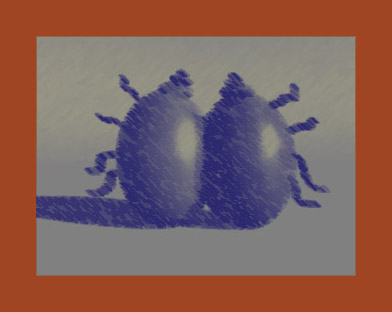
Every year brings news items about Lyme disease. Here is some information about this disease: how it is transmitted; how to avoid it; its diagnosis and treatment.
How Lyme Disease is Transmitted: the Blacklegged Tick
The culprits spreading Lyme disease to people are the blacklegged tick, Ixodes scapularis, and the western blacklegged tick. Their more common names are "deer tick" and "bear tick", respectively. Alternate spellings are "black legged tick" or "black-legged tick".
Infected blacklegged ticks (deer ticks) are found in Minnesota and Wisconsin, Manitoba, Ontario, Quebec, and the Atlantic coast from Virginia through Maine, new Brunswick and Nova Scotia. the western blacklegged tick (bear tick) inhabits western states and provinces.
Blacklegged ticks normally live on wild animals – not just deer, but also rodents and birds. These ticks, a type of mite, will also spend time on plants such as trees or grasses. a blood meal may last five days.
A deer tick may take in the bacteria Borrelia burgdorferi, which causes Lyme disease, from an animal she bites. When the infected tick next wants a meal, she will climb a plant and wait to ambush the next convenient host – perhaps a hiker in the woods. Surprisingly, the chance of infection is rather low since the tick must carry the bacteria, and must stay attached long enough for the bacteria to travel to the person.
These ticks may also transmit other diseases, whether caused by bacteria or parasites.
Avoiding Lyme Disease by Avoiding Deer Ticks
Most city dwellers may never hike in woods inhabited by the blacklegged tick. Part of planning a camping trip should include a check with the local conservation authority, to learn whether blacklegged ticks are common in the area. Alternatively, public health officials issue warnings about Lyme disease in affected areas. Protective clothing includes long pants tucked into boots, and long sleeves that are snug at the wrists. Repellant containing DEET should be worn.
Prompt removal of ticks will also help prevent infection. a willing partner is an important asset in this task; so is a pair of tweezers. the method is to take the head nearest the skin, then to pull the tick out quite slowly and without twisting or crushing it. (Squeezing the abdomen would propel contaminants into the victim). a wash with soap and water, and then a swab with rubbing alcohol or disinfectant completes the removal. Saving dead ticks in a pill bottle may aid in later diagnosis. It is also wise to log the date of the bite.
It is not easy to see a hungry blacklegged tick. It ranges in size from poppy seed to sesame seed. the abdomen becomes much larger after a blood meal, so it would be easier to see the tick.
The blacklegged tick has no need for deer as a host population, since it also thrives on blood from birds or rodents. the bacteria, in fact, are more common in mice than in deer. there is no evidence that reducing the deer population reduces the tick population. Likewise, avoiding or hunting deer does not make a difference in the likelihood of encountering blacklegged ticks. Again, not every tick carries infectious agents, and not every bite passes bacteria into the "victim".
Diagnosis of Lyme Disease
Diagnosis can be difficult, since Lyme disease may affect various body parts and different people display a range of symptoms. Diagnostic guidelines in Canada include taking the patient’s history – was she exposed to these ticks – and symptoms into account. Blood tests for Lyme disease are fallible, especially in the early stages, so proof of exposure is very important. (Having dead blacklegged ticks in a bottle is useful evidence).
The most common first sign is a target-shaped rash. this may develop one day or one month after being bitten. It usually clears up within a month after it starts. Other early symptoms may include fever or chills, painful or swollen joints, headache and fatigue.
For the next several months, other symptoms might develop. they include heart palpitations, fatigue and weakness, rashes, symptoms mimicking arthritis, and problems with the nervous system. without treatment, these latter symptoms may continue for years.
Treatment of Lyme Disease
Once diagnosed in an early stage, antibiotic drugs such as amoxicillin, ceftriaxone, or doxycycline are usually prescribed for a period of two to four weeks. Intravenous ceftriaxone or penicillin might be necessary depending on the patient’s other conditions. if the diagnosis was delayed, treatment might be more lengthy and complex.
Sonja Puzic filed a report in the Windsor Star (Windsor, Ontario): "Lyme Disease on Rise". In it, she described one patient’s lengthy bout of Lyme disease in which the diagnosis was delayed.
Hope for the Hiker
Most hikers will not encounter these ticks. Not all blacklegged ticks carry Lyme disease. It is possible to get rid of the tick before it transmits Lyme disease to the hiker. Effective treatments are available.
References:
Kids Health (online): kidshealth.org, referenced July 21, 2010.
Ontario Ministry of Health, modified Dec. 17, 2009, referenced July 21, 2010.
Public Health Agency of Canada, referenced July 21, 2010.
Sonja Puzic, "Lyme Disease on Rise", Windsor Star, June 21 2010, referenced July 21, 2010
USA Center for Disease Control, referenced July 21, 2010.
Disclaimer: the information contained in this article is for educational purposes only and should not be used for diagnosis or to guide treatment without the opinion of a health professional. Any reader who is concerned about his or her health should contact a doctor for advice.